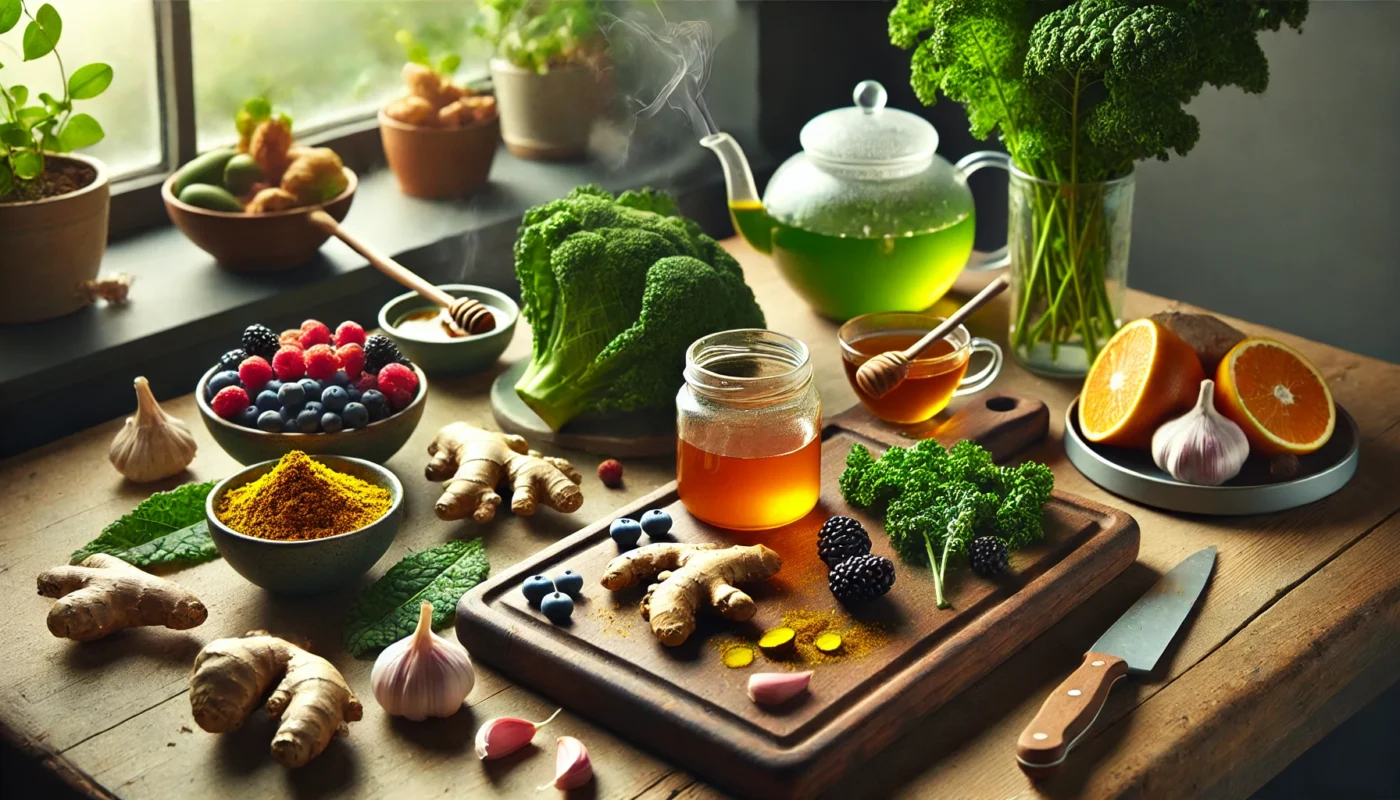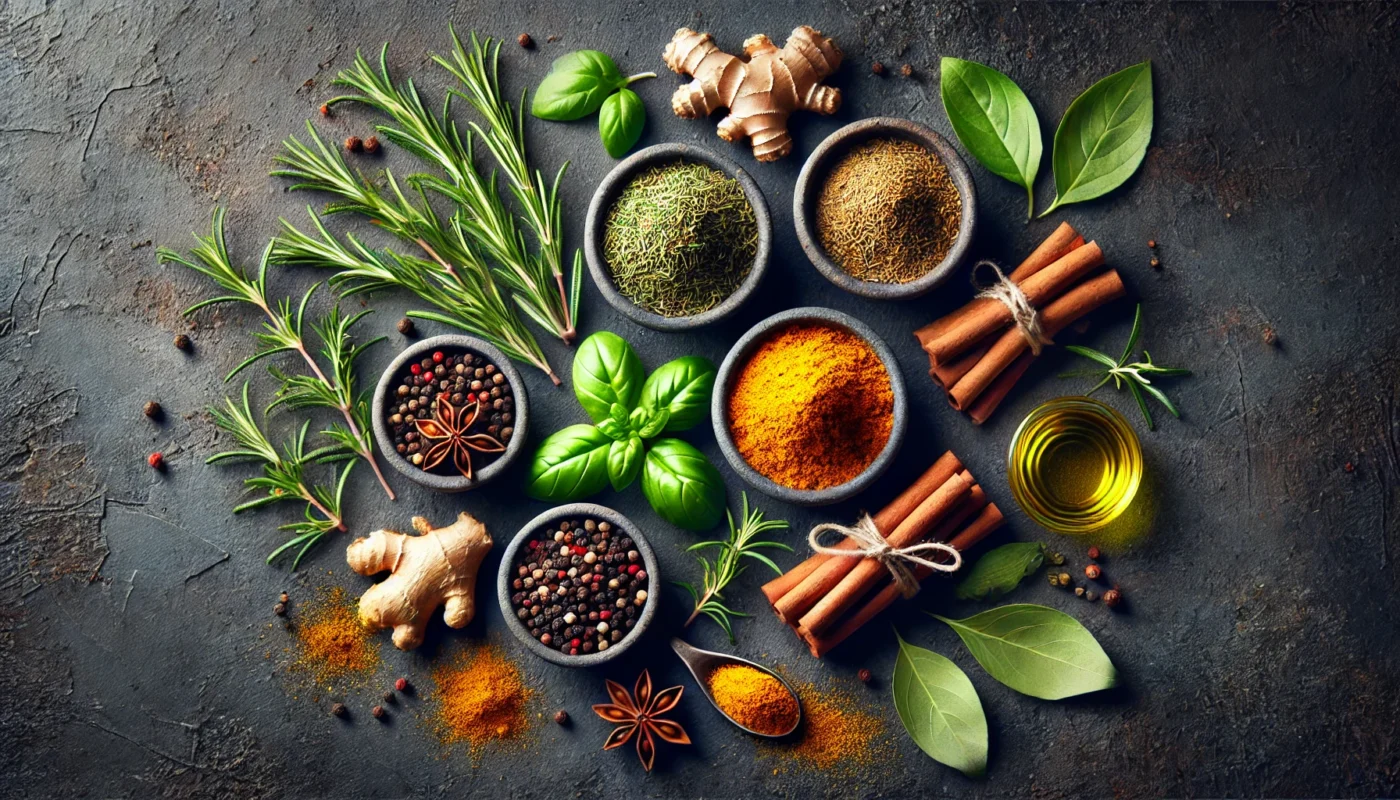Inflammation is a natural response of our bodies. It’s a defense mechanism against injury, infection, and disease.
However, when inflammation becomes chronic, it can lead to serious health issues. These include heart disease, diabetes, and arthritis, among others.
Diet plays a crucial role in managing inflammation. Certain foods can either trigger or reduce inflammation in our bodies.
This is where anti-inflammatory foods come into play. They are rich in antioxidants and other nutrients that help combat inflammation.
Incorporating these foods into your diet can offer numerous health benefits. They can help manage existing conditions, prevent potential health risks, and improve overall wellbeing.
This comprehensive guide will delve into the science behind anti-inflammatory foods. It will explore herbs, spices, and other foods known for their anti-inflammatory properties.
We will also provide practical tips on how to integrate these foods into your daily meals. Our goal is to help you optimize your health and manage inflammation through diet.
So, whether you’re a fitness enthusiast, a health enthusiast, or a medical patient, this guide is for you. Let’s embark on this journey towards better health and wellbeing.
You May Also Like: 20 Powerful Anti-Inflammatory Foods to Try
Understanding Inflammation and Its Effects on Health
Inflammation is the body’s response to harmful stimuli. These stimuli can range from pathogens to irritants. It plays a crucial role in the body’s healing processes.
There are two types of inflammation: acute and chronic. Acute inflammation occurs in response to tissue injury or infection. It is short-lived and part of the healing process.
Chronic inflammation, however, is prolonged and can persist for months or years. It’s linked to various diseases, including heart disease, diabetes, and certain cancers. Chronic inflammation can harm healthy tissues and lead to lasting damage.
Diet is a significant factor in inflammation levels within the body. Consuming certain foods regularly can increase inflammation, while others help reduce it. Understanding these dietary impacts can be transformative for your health.
By identifying the foods that promote or alleviate inflammation, individuals can better manage inflammation-related conditions. This understanding is essential for making informed dietary choices. Reducing inflammation can lead to improved health outcomes and enhanced overall wellbeing.
The Science Behind Anti-Inflammatory Foods
Our food choices directly impact inflammation within our bodies. Scientific research highlights how certain foods possess powerful anti-inflammatory properties. These foods help mitigate chronic inflammation.
Anti-inflammatory foods are rich in nutrients and compounds. These can include antioxidants, omega-3 fatty acids, and various phytochemicals. These components play a significant role in reducing inflammation.
Antioxidants help neutralize free radicals, preventing cell damage. Omega-3 fatty acids are known to disrupt inflammatory pathways. Both are critical for maintaining low levels of inflammation.
A diet rich in anti-inflammatory foods benefits various conditions. Conditions such as arthritis, heart disease, and diabetes can improve. Integrating these foods can alleviate symptoms and enhance life quality.
Research supports the benefits of these foods. Studies demonstrate their efficacy in reducing inflammatory markers. This evidence is crucial for developing effective dietary strategies.
Thus, embracing anti-inflammatory foods contributes to overall health. These foods can alter inflammatory processes positively. The scientific basis for such diets is compelling and increasingly recognized.
The Role of Antioxidants and Omega-3s
Antioxidants are crucial in the fight against inflammation. They help neutralize harmful free radicals that contribute to oxidative stress. This stress can lead to chronic inflammation and disease.
Foods high in antioxidants include berries, leafy greens, and nuts. Incorporating these foods can significantly reduce oxidative damage. They work synergistically with other nutrients to promote health.
Omega-3 fatty acids also play a vital role. Found in fatty fish and certain seeds, they modulate inflammatory pathways. This modulation helps lower overall inflammation levels in the body.

Anti-Inflammatory Herbs and Spices: A Closer Look
Herbs and spices do more than flavor our foods. They contain bioactive compounds with potent anti-inflammatory effects. These natural ingredients have been used for centuries in traditional medicine.
Among these, turmeric and ginger stand out for their anti-inflammatory properties. Turmeric’s curcumin and ginger’s gingerol have attracted scientific interest. These components actively combat inflammation within the body.
Several other herbs and spices are noteworthy. These include rosemary, oregano, and cinnamon. They also contribute to reducing inflammation and promoting healing.
Here is a list of some of the best anti-inflammatory herbs and spices:
- Turmeric
- Ginger
- Garlic
- Cinnamon
- Rosemary
- Oregano
- Cloves
Including these in your diet can enhance flavor and health benefits. They are versatile and can fit into various dishes and cuisines. Their inclusion can transform a meal into a health-boosting powerhouse.
Research on these ingredients continues to reveal more insights. Studies focus on their effectiveness and potential applications. This ongoing research highlights their promise in health management.
Turmeric, Ginger, and Beyond: Spices That Decrease Inflammation
Turmeric is renowned for its anti-inflammatory properties. Its active compound, curcumin, is known to inhibit inflammation pathways. It’s a staple in various traditional medical practices worldwide.
Ginger, with its spicy notes, also offers anti-inflammatory benefits. Gingerol, its main bioactive compound, has numerous health effects. These include reducing inflammation and pain associated with various conditions.
Other spices like cinnamon and cloves also help decrease inflammation. They possess compounds that aid in reducing blood sugar and inflammation. Incorporating them into your diet can provide added health benefits.
Garlic and Other Anti-Inflammatory Foods
Garlic is a powerful anti-inflammatory food. It contains sulfur compounds, such as allicin, known to reduce inflammation. These compounds can modulate immune responses and improve health.
Other foods, like leafy greens and fatty fish, also offer anti-inflammatory effects. Leafy greens are packed with antioxidants, and fatty fish are rich in omega-3s. These foods provide critical nutrients that help manage inflammation.
Understanding how these foods work can inform dietary choices. Incorporating them regularly supports long-term health. They can enhance the body’s natural defenses against inflammation.
Nightshades and Inflammation: Understanding the Controversy
Nightshade vegetables have a controversial reputation. Some claim they worsen inflammation. However, scientific consensus on this is not definitive.
Nightshades include tomatoes, bell peppers, and eggplant. They contain solanine, an alkaloid some believe triggers inflammation. People with certain conditions might react to these compounds.
Yet, many studies suggest nightshades offer health benefits. They provide vitamins, minerals, and antioxidants. Most individuals can consume them without issues.
The debate over nightshades continues. More research is necessary to clarify their effects. Consulting with healthcare professionals can provide personalized advice.

Creating an Anti-Inflammatory Diet: Practical Tips and Meal Ideas
Transitioning to an anti-inflammatory diet can be straightforward with a few adjustments. The key is incorporating a variety of nutrient-rich foods that naturally reduce inflammation. This approach not only aids in managing inflammation but promotes overall health as well.
Begin by focusing on whole foods rich in antioxidants and omega-3 fatty acids. Fresh fruits and vegetables should form the core of your diet. Incorporating colorful produce ensures a spectrum of vitamins and antioxidants.
Choosing the right fats is crucial. Opt for healthy fats found in olive oil, nuts, and seeds. These choices provide essential fatty acids that combat inflammation.
Herbs and spices are easy additions that enhance flavor while offering health benefits. Spices such as turmeric, ginger, and garlic can be added to numerous dishes. Their anti-inflammatory properties are well-supported by research.
Here’s a simple checklist to help you get started:
- Focus on fresh fruits and vegetables.
- Prioritize whole grains like brown rice and quinoa.
- Choose lean protein sources such as fish and legumes.
- Use olive oil instead of butter for cooking.
- Add anti-inflammatory spices to your meals.
Consistency is important when following an anti-inflammatory diet. Regularly consuming these foods supports long-term health benefits. With time, this way of eating can become a natural part of your lifestyle.
Incorporating Anti-Inflammatory Foods into Your Daily Meals
Incorporating anti-inflammatory foods into your daily routine doesn’t have to be complicated. Start by gradually introducing these foods into meals you already enjoy. This way, you enhance the nutritional value without feeling overwhelmed.
For breakfast, consider oatmeal topped with berries and nuts. These foods are rich in antioxidants and healthy fats. Such a meal can naturally reduce inflammation while providing a balanced start to your day.
Lunch can feature a salad with leafy greens, mixed vegetables, and a protein source. Adding salmon or chickpeas offers omega-3s and plant-based proteins. A drizzle of olive oil and a sprinkle of turmeric can add depth to your salad.
For dinner, think about grilled fish with a side of roasted vegetables. Vegetables like broccoli and sweet potatoes are excellent choices. Seasoning with ginger or rosemary can further boost the meal’s anti-inflammatory potential.
Here’s a quick list of meal ideas to spark inspiration:
- Berries and chia pudding
- Spinach and lentil soup
- Quinoa salad with mixed nuts
- Sautéed greens with garlic and olive oil
Being creative with these foods helps maintain interest. Over time, these meals become staples in your anti-inflammatory diet.
Sample Anti-Inflammatory Meal Plan
Creating a structured meal plan helps ensure adherence to an anti-inflammatory diet. A sample plan provides guidance and variety, making it easier to stay on track.
For breakfast, start with a smoothie. Blend leafy greens with a banana and a handful of berries. Adding a spoonful of flaxseeds provides a healthy dose of omega-3s.
Lunch could feature a quinoa bowl. Include assorted vegetables, a lean protein like grilled chicken, and a sprinkle of turmeric. This meal can keep energy levels steady while reducing inflammation.
Dinner should focus on balance. Opt for baked salmon with a medley of roasted vegetables. Complement with a side of brown rice for a complete and satisfying meal.
Here’s a sample meal plan to consider:
- Breakfast: Green smoothie with spinach, banana, and berries
- Lunch: Quinoa bowl with vegetables and grilled chicken
- Dinner: Baked salmon with roasted vegetables and brown rice
- Snacks: Almonds or a piece of dark chocolate
Incorporating these diverse meals helps maintain dietary satisfaction. Such a plan provides nutrients essential for inflammation reduction and overall health. Consistent adherence amplifies the benefits and supports wellness goals.
The Impact of Lifestyle on Inflammation
Inflammation is not solely influenced by diet; lifestyle factors play a significant role as well. Our daily habits, from physical activity to rest, can affect inflammation levels in the body.
Stress is a powerful driver of inflammation. Chronic stress triggers the release of hormones that can exacerbate inflammatory responses. Finding effective stress management techniques is crucial in reducing inflammation.
Sleep, often overlooked, is fundamental for bodily repair and regulation. Poor sleep can increase inflammatory markers, impacting health negatively. Prioritizing quality sleep is essential for overall well-being and reducing inflammation.
Exercise, Stress, and Sleep: The Holistic Approach
Regular exercise is a cornerstone of a holistic approach to managing inflammation. Physical activity improves circulation and encourages the body’s natural anti-inflammatory processes. Even moderate exercise can yield substantial health benefits.
Stress management techniques, such as meditation or yoga, can significantly lower stress levels. By calming the mind, these practices help diminish the production of stress hormones. Reducing stress is a key component of decreasing chronic inflammation.
Adequate sleep is vital for maintaining low inflammation levels. Prioritizing restful sleep supports immune function and cellular repair. Establishing a consistent sleep schedule helps optimize recovery and reduce overall inflammation.

Potential Risks and Considerations
While anti-inflammatory foods offer many benefits, there are potential risks to be aware of. Overconsumption of certain herbs or spices can lead to unwanted side effects. Moderation and variety in your diet are key to avoiding these issues.
Additionally, not every food affects each person the same way. Some individuals may experience allergic reactions or sensitivities. It’s important to monitor how your body responds to different foods and adjust accordingly.
Interactions with Medications and Conditions
It’s crucial to consider how anti-inflammatory foods might interact with medications. Some herbs and spices could interfere with drug efficacy or increase side effects. Always consult with a healthcare provider before making significant dietary changes.
Certain medical conditions may also require specific dietary considerations. Individuals with chronic illnesses should ensure that dietary adjustments do not exacerbate symptoms. Professional guidance can help tailor an anti-inflammatory diet to individual health needs.
Conclusion: The Balanced Path to Reducing Inflammation
Incorporating anti-inflammatory foods is a practical step toward better health. This dietary approach can potentially reduce inflammation and enhance overall well-being. By understanding which foods and spices offer such benefits, you empower yourself to make informed choices.
However, achieving balance is key. Pair dietary changes with lifestyle adjustments, such as regular exercise and stress management, for optimal results. Consult healthcare professionals to ensure the chosen path suits your personal health needs. With a thoughtful approach, you can effectively manage inflammation and foster a healthier lifestyle.
Further Reading:
Harvard Health Publishing: Foods that fight inflammation
Children’s Hospital at Philadelphia: Food as Medicine: Anti-Inflammatory Diet
Cleveland Clinic: Why and How To Start an Anti-Inflammatory Diet
anti-inflammatory diet, healthy eating, meal planning, nutrition, inflammation reduction, lifestyle changes, exercise, stress management, sleep health, holistic health, wellness, dietary guidelines, omega-3s, plant-based proteins, balanced meals, health tips
Important Note: The information contained in this article is for general informational purposes only, and should not be construed as health or medical advice, nor is it intended to diagnose, prevent, treat, or cure any disease or health condition. Before embarking on any diet, fitness regimen, or program of nutritional supplementation, it is advisable to consult your healthcare professional in order to determine its safety and probable efficacy in terms of your individual state of health.
Regarding Nutritional Supplements Or Other Non-Prescription Health Products: If any nutritional supplements or other non-prescription health products are mentioned in the foregoing article, any claims or statements made about them have not been evaluated by the U.S. Food and Drug Administration, and such nutritional supplements or other health products are not intended to diagnose, treat, cure, or prevent any disease.

